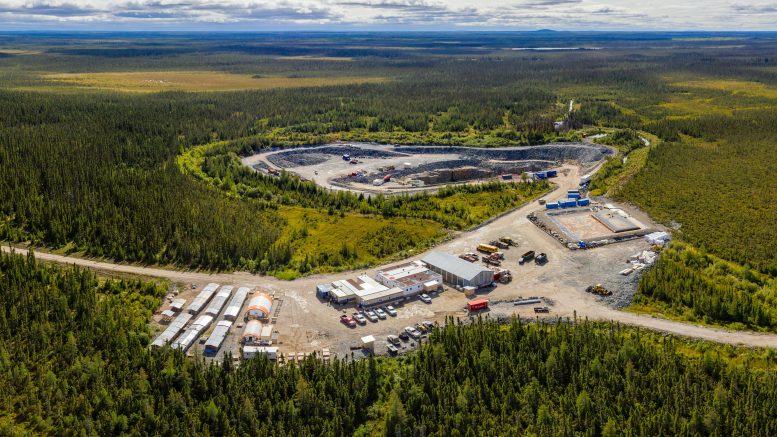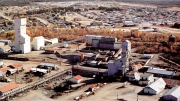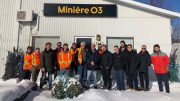Wallbridge Mining‘s (TSX: WM) flagship Fenelon gold project lies along the prospective Detour-Fenelon gold trend in north-western Quebec, 75 km west-northwest of Matagami.
The 85.6 sq. km land package is 1 km north of the Sunday Lake Deformation Zone (SLDZ), a major east-west structure in the northern Abitibi greenstone belt, which also hosts Kirkland Lake Gold’s (TSX: KL: NYSE: KL) Detour Lake open-pit gold mine in Ontario, Canada’s second-largest gold mine, 80 km west of Fenelon.
Wallbridge purchased Fenelon for $3.7 million in October 2016 from Balmoral Resources. The property contains the Gabbro, Tabasco-Cayenne, Area 51, and Ripley-Reaper mineralized zones.
“At the time, Fenelon was a small property of about 1,000 hectares, and we borrowed the money for the purchase from one of our shareholders, William Day Construction,” Marz Kord, the company’s president and chief executive, said in an interview. “As we set about exploring it, we realized that the belt on which it lies had seen very little exploration and that Balmoral Resources owned the majority of the properties in the area.”
In May of this year, Wallbridge acquired Balmoral in an all-stock transaction valued at $150 million, which gave Wallbridge a district-scale land position totalling over 900 sq. km along the eastern extension of the Sunday Lake Deformation Zone.
The acquisition brought together Wallbridge’s Fenelon gold project with Balmoral’s significant landholdings, which included the nearby Martiniere and Grasset gold and nickel assets, the Detour East gold project, the Jeremie nickel, copper, platinum group elements, zinc, silver, and gold project, the Harri gold and base metal project, and the Doigt gold project.
“Fenelon offers the potential for a multi-million-ounce deposit in one of the top mining jurisdictions in the world,” Kord said. “The region has excellent infrastructure, direct road access to the site all-year-round, access to hydroelectric power in less than 20 km, and friendly local First Nation communities that we meet with weekly.”
The gold systems on the property, Kord noted, are very similar to those found in mines in the Timmins and Red Lake mining districts of Ontario, and the Cargo Muchacho mining district in Arizona, which are all orogenic gold systems typically hosted along main breaks like the SLDZ.
Gold mineralization on Fenelon was first discovered by Cyprus Canada Ltd. in 1988, leading to the discovery of the Main Gabbro zones, then called the Discovery zone, in 1994.
Balmoral acquired Fenelon in the fall of 2010 and the following year completed a 41-hole drill program totalling 8,580 metres to test the lateral and down-dip/plunge extensions of the Discovery Zone and its eastern and northern ends. The program extended some mineralized veins in the zone along strike and to a depth of 250 metres.
After purchasing the property in 2016, Wallbridge conducted a review of historic drill core samples from around the mine workings and examined previously unsampled drill core.
A total of 399 drill cores were assessed, with 83 returning gold values above 0.1 gram gold per tonne and 37 showing over 0.5 gram gold per tonne.
“The results from this initial exploration program were very encouraging and clearly showed that there was considerable upside potential at Fenelon to add ounces close to the mine workings,” Kord said.
In March 2017, the company released a prefeasibility study (PFS), which outlines an underground mine with a life of 18 months producing a total of 28,922 oz. gold at an average all-in sustaining costs (AISCs) of US$1,105.79 per ounce. Initial capex was pegged at $5.24 million, and the early-stage study estimated an after-tax net present value of $2.8 million at a discount rate of 5%, with an after-tax internal rate of return of 60%.
The PFS was based on a mineral resource estimate of 91,100 tonnes of measured and indicated resources grading 12.97 grams gold for 38,000 oz. gold. Inferred resources added 6,500 tonnes grading 9.15 grams gold for 1,900 oz. gold.
By the end of 2017, the company had drilled 33 holes totalling 6,438 metres. The drilling confirmed gold mineralization up to 120 metres from the Main Gabbro zones and identified two new gold-bearing structures, the Cayenne and Tabasco zones.
In 2018, the company completed a 21-hole 9,740-metres surface drill program that followed known mineralized zones to depths of 300-400 metres and tested for additional zones away from the mine workings. The last hole of the drilling campaign, 18-051, intersected a 200-metre-wide and previously unknown package of favourable intermediate to mafic rocks that hosted a stockwork of gold-bearing veins surrounding higher-grade shear zones similar to those found in the main deposit. The new area, 500 metres south of the Main Gabbro zones, was named the Area 51 zone.
That same year, Wallbridge also completed 92 drill holes of an underground drill program totalling 10,959 metres, with visible gold observed in 50% of the holes. The drilling extended known gold zones and discovered new parallel zones, the Naga Viper and Chipotle zones, located on the eastern end of the Main Gabbro zones.

Geologists from Wallbridge Mining operating an underground drill rig at its Fenelon gold project. Credit: Wallbridge Mining.
Last year, Wallbridge dewatered the open-pit and existing underground infrastructure in the Main Gabbro zones, and completed 2,100 metres of underground development, establishing four mining horizons and workings to explore the first 100 metres from surface.
Wallbridge released the results from a 33,233-tonne bulk sample program in May. The material was taken from five stopes and returned a reconciled average grade of 18.49 grams gold for 19,755 contained oz. gold.
A further 2,277 tonnes of low-grade ore included in the bulk sample from previous operators returned a reconciled grade of 4.23 grams gold for 310 oz. gold.
“Overall, the bulk sample results met or exceeded our initial projections in terms of grade and gold recovery and established that Fenelon could be mined at good grades using relatively low-cost bulk mining methods,” Kord said.
By the end of 2019, Wallbridge had completed a surface drill program comprising 56 drill holes totalling 42,889 metres. The drilling successfully extended the high-grade gold mineralization to 850 metres vertical depth at the Tabasco zone, which remains open along strike and at depth.
The drilling also tested mineralization in the Area 51 zone. Highlights include drill hole 19-052, which intersected 228 metres grading 1.46 grams gold from 363 metres, including 11 metres grading 15.93 grams gold. Hole 19-059 cut 78 metres grading 1.02 grams gold from 308 metres, including 18 metres grading 3.28 grams gold.
The company also completed an underground infill drill program last year of 167 drill holes totalling 31,558-metres designed to extend the known mineralized zone below the bulk sample development to a depth of 350 metres.
This year the company had planned to drill 100,000-120,000 metres. However, restrictions imposed due to the coronavirus pandemic forced it to suspend its drill program in March. The company resumed exploration in late May.

A worker from Wallbridge Mining logging core samples at the company’s Fenelon gold project. Credit: Wallbridge Mining.
“Although we revised our guidance on exploration for the year, I’m confident that we will complete around 100,000 metres of drilling by the end of the year,” Kord said. “To date, we’ve completed about 75,000 metres and have already demonstrated that the near-surface mineralization has the potential to become an open-pit deposit.”
The 2020 drill program is focused on infill drilling along 75-metre step-outs along strike and to depth. Next year the company plans to drill about 150,000 metres and complete an updated resource estimate before the end of the third quarter that will include for the first time the Main Gabbro, Tabasco, Cayenne, and Area 51 zones.
In addition, Wallbridge intends to start a 10,000-metre, multi-year development program, to establish underground drilling platforms in Area 51 and Tabasco in 2021. The program will include tightly-spaced drilling in Area 51, the Lower Tabasco, and Cayenne zones down to 1,500 metres vertical depth, along with mapping and sampling of the zones from underground.
“The 2020-2021 exploration programs are fully-funded with around $112 million,” Kord said. “We’ve spent some of that money on this year’s program and have a little over $80 million left in the treasury to fund next year’s work.”
The company is also looking to spend about 10-15% of next year’s budget on its regional assets, including follow-up work on newly acquired land south of the Sunday Lake Deformation Zone and its Martiniere gold project, 30 km west of Fenelon. Resources at Martiniere stand at 7.92 million indicated tonnes grading 2.32 grams gold for 590,642 ounces. Inferred resources add 363,420 tonnes grading 4.57 grams gold for 53,344 ounces.
Wallbridge also has an option agreement with Midland Exploration (TSXV: MD) to earn a 50% interest in the Casault gold project, 40 km east of the Detour Lake deposit. Under the agreement, Wallbridge must spend $5 million on exploration over four years, including $750,000 during the first year.
In September, the company signed a non-binding term sheet for a joint venture on its Detour East gold project with Kirkland Lake Gold. Under the deal, Kirkland can earn a 75% interest in Detour East by spending $35 million on the property.
“The joint venture agreement will allow us to focus on fully-defining the size potential of Fenelon while also advancing exploration on Detour East located at the far west end of our land position,” Kord said.
Wallbridge also has a 20% stake in Loncan Canada, a privately-held company with an extensive portfolio of nickel, copper, and platinum group metal projects in Ontario’s Sudbury Basin.
The company has attracted a range of investors. Mining investor Eric Sprott holds a 20.7% stake in the company, Kirkland Lake Gold owns about 9.9%, William Day Construction about 7.1%, and the VanEck Vectors Gold Miners Exchange about 3.8 percent.
At press time in Toronto, Wallbridge was trading at 83¢ per share within a 52-week trading range of 32.5¢ and $1.35. The company has 789 million common shares outstanding for a $654.5-million market capitalization.






I have been a shareholder from 8 cents. It is my hope that a decision on mining can be reached in a reasonable time frame. I am an accountant and look forward to great things….Noel F.